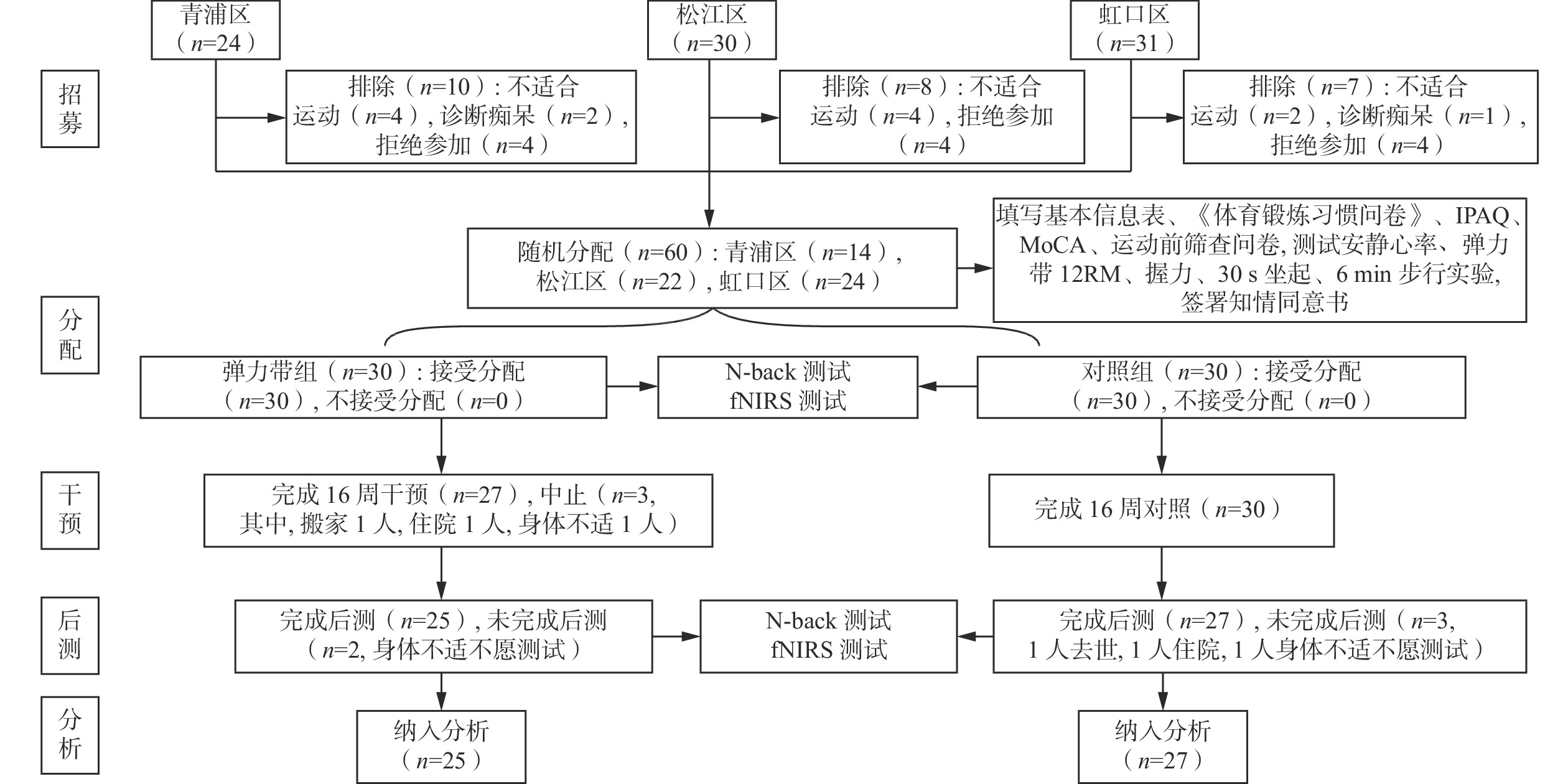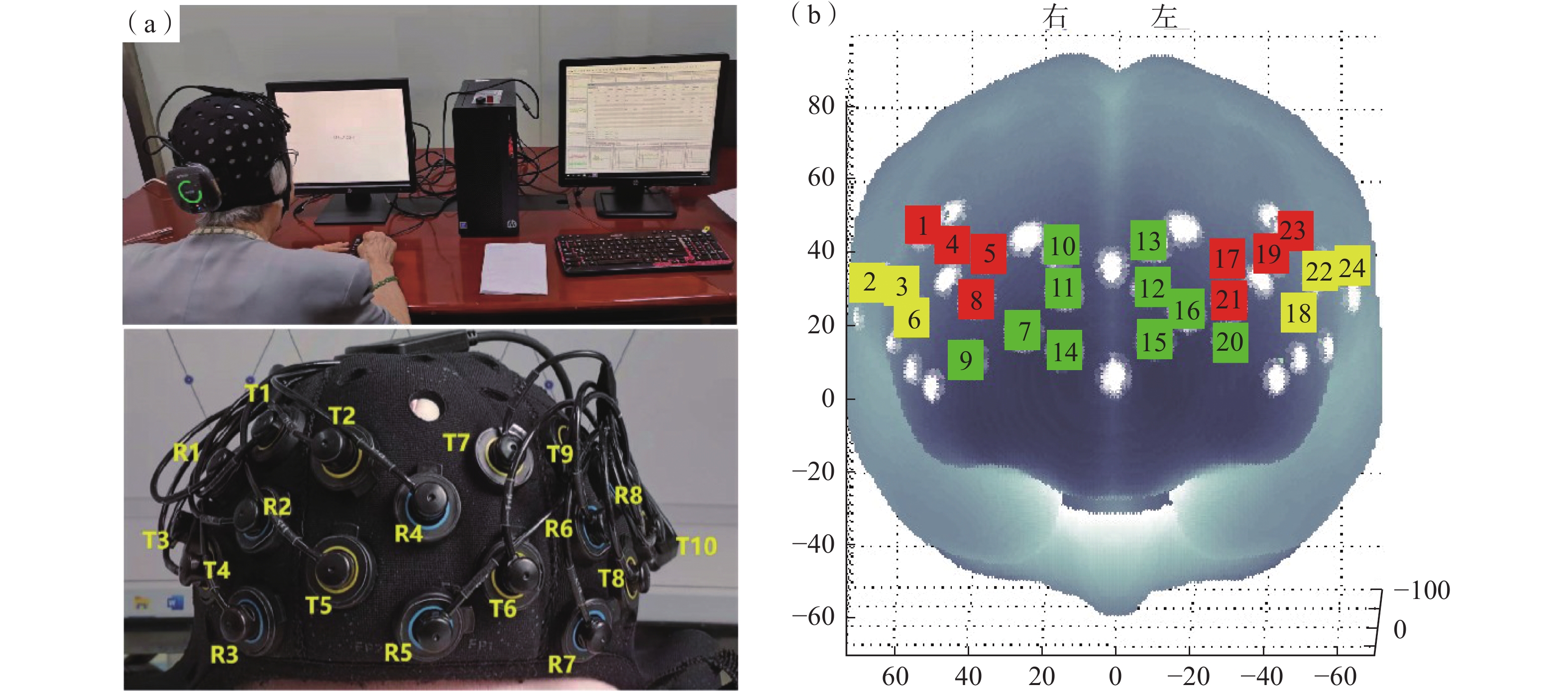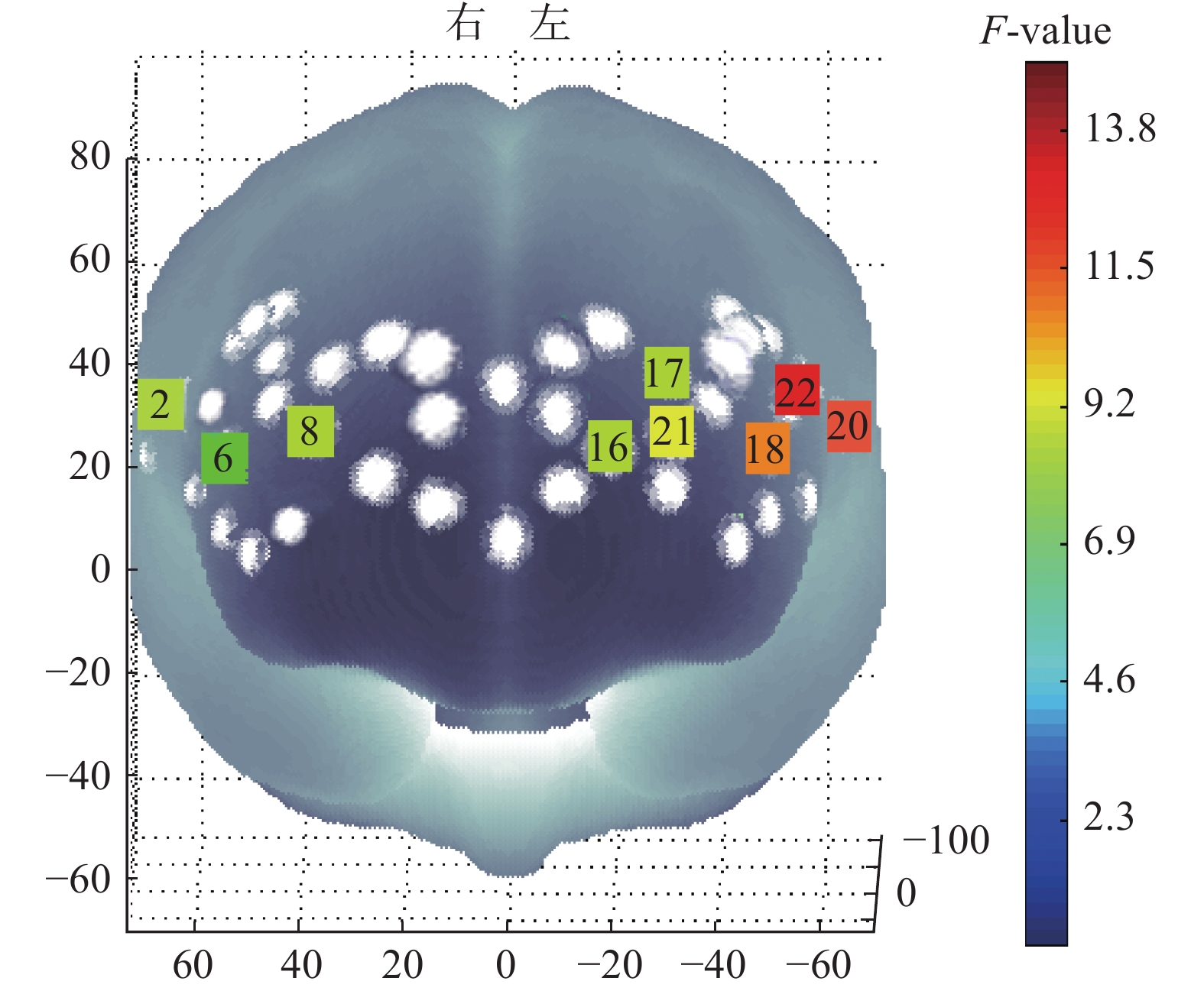Effects of Elastic Band Resistance Exercise on the Working Memory in the Aged PeopleEvidence from fNIRS
-
摘要:目的
观察长期弹力带运动改善高龄老年人工作记忆的效果,采用近红外光谱技术探究可能的脑机制。
方法将60名高龄老年人随机分为弹力带组与对照组,弹力带组接受16周、每周3次、每次40 min的弹力带干预,对照组保持原有生活状态;采集实验前后受试者完成工作记忆任务期间的前额叶血流动力学指标。
结果反应时的时间×组别交互效应具有统计学意义(P<0.001);正确率的时间×记忆负荷交互效应具有统计学意义(P=0.003);正确反应率的时间×组别交互效应具有统计学意义(P<0.001);氧合血红蛋白结果显示,9条通道组别×时间×记忆负荷交互效应均具有统计学意义(P<0.002)。
结论规律性中低强度弹力带抗阻运动能改善高龄老年人的工作记忆表现;在低记忆负荷时前额叶激活不明显,中、高记忆负荷时双侧腹外侧前额叶、左背外侧前额叶、左额极区显著激活,这种前额叶激活优化模式可能是弹力带抗阻运动改善工作记忆的脑机制。
Abstract:ObjectiveTo examine the effect of elastic band exercise in improving the working memory in aged people, and to explore the potential brain mechanism by functional Near Infrared Spectroscopy (fNIRS).
MethodsSixty aged people were randomly divided into an elastic band group (EBG) and a control group (CG). EBG received elastic band intervention for 16 weeks, 3 times a week, 40 minutes each time, and CG maintained the original living condition. The subjects' prefrontal cortex hemodynamics during the N-back task were measured before and after the intervention.
ResultsThe time×group interaction of reaction time (RT) was statistically significant (P<0.001). The interaction effect of time×working memory load at accuracy was statistically significant (P=0.003). The interaction effect of time×group at rate-correct score was statistically significant (P<0.001).The results of HbO2 showed that the interaction effect groups×time×working memory load was statistically significant in 9 channels (P<0.002).
ConclusionRegular low-to-morderate-intensity elastic band resistance exercise improved the working memory performance in aged people. The activation of the prefrontal cortex was not significant at low working memory loads, and the activity of the bilateral ventrolateral prefrontal cortex, left dorsolateral prefrontal cortex and left frontopolar cortex area were increased at medium and high memory loads. This optimized prefrontal cortex activation pattern may be the brain mechanism by which resistance exercise improves working memory.
-
随着我国老龄化的不断深入,高龄化趋势日益凸显,高龄老年人认知功能损害已成为影响其生活质量的重要因素。我国60~69岁、70~79岁、80~89岁、90岁及以上4个年龄段轻度认知障碍(Mild Cognitive Impairment,MCI)的患病率分别为11.83%、19.23%、24.15%、32.46%,痴呆患病率分别为2.89%、8.38%、14.35%、31.23%[1],随着年龄的增大,MCI、痴呆的患病率急剧增加。工作记忆是一种对增龄性衰退特别敏感的高级认知功能[2],高龄老年人的工作记忆衰退比低龄老年人更为严重,工作记忆衰退预示着转化为MCI、痴呆的风险增加[3-4]。因此,探索有效预防或延缓工作记忆衰退的体育锻炼方案及潜在脑机制对提高高龄老年人健康水平、实现健康老龄化具有重要的理论意义和社会价值。
研究[5-6]表明,体育锻炼能改善老年人的整体认知功能、抑制功能,但能否通过一定手段改善老年人的工作记忆目前仍存在争议。有研究发现:6个月的太极拳、广场舞干预均能改善老年人N-back(工作记忆测试)任务的反应时和正确率[7];12周的抗阻运动改善了老年人数字倒背、顺背的绩效(数字广度)[8]。但是也有研究发现了相反的结果:Kramer等[9]发现有氧运动干预后N-back、数字广度的表现均无显著提升;16周的多成分训练(有氧、抗阻、平衡、协调等)没有显著提升老年人的数字字母排序任务绩效[10];12个月的抗阻运动改善了抑制功能,但没有改善工作记忆(数字广度)[11]。现有多数研究将工作记忆仅作为认知功能的一个方面进行研究,鲜有针对性研究,且测试工具不统一,体育锻炼的干预效果需要更多研究证实。另外,哪种类型的体育锻炼对工作记忆的干预效果更好目前未达成共识。研究[12]显示,有氧运动、抗阻运动均能改善老年人工作记忆,但二者的机制可能存在差异。目前的研究多以有氧运动为干预手段,抗阻运动能否改善老年人工作记忆?其潜在机制是什么?回答这些问题需要更多的研究证据。
功能性近红外光谱(functional Near Infrared Spectroscopy,fNIRS)是一种非侵入式光学测量方法,其利用近红外光在脑组织中一系列吸收、散射后出射光携带的与脑组织光学特性相关的生化信息,推断大脑的神经激活情况[13]。fNIRS结合了脑电和核磁共振的优点,既有较高的时间分辨率,又有较高的空间分辨率,且具有便携、生态效度高、成本低、抗干扰能力强等特点,特别适合运动改善认知功能的脑机制研究。采用fNIRS研究发现:中等强度自行车运动改善了老年人2-back的表现,且伴随着左侧前额叶的激活增强[14];太极拳运动显著缩短了Flanker(抑制功能测试)任务的反应时,且任务过程中前额叶氧合血红蛋白(Oxygenated Hemoglobin,HbO2)水平显著升高[15];飞力士棒运动显著增强了Stroop(抑制功能测试)任务过程中额极区(Frontopolar Cortex Area,FPA)的激活程度[16]。前人采用fNIRS的研究较为深入地探讨了运动改善抑制功能的机制,而对工作记忆的研究非常少。本文通过fNIRS手段探究弹力带抗阻运动改善工作记忆的潜在脑机制。基于前人研究提出2个假设:①16周的弹力带抗阻运动可能显著缩短高龄老年人的N-back反应时,提高正确率、正确反应率(Rate-Correct Score,RCS);②实验组实验后前额叶某些区域神经激活更明显,并且随着记忆负荷的增加激活区域可能会发生改变。
1. 研究对象与方法
1.1 研究设计
通过单盲随机对照试验,评价16周的弹力带抗阻运动对高龄老年人工作记忆的影响与前额叶激活的变化。使用分层随机化方法,将养老院作为分层因素,给每个养老院的受试者从“1”开始编号;然后使用SPSS 22.0软件“转换—随机数字生成器”生成与受试者数量相同的随机数字,并与受试者编号一一对应;最后使用SPSS 22.0 软件“数据—选择个案”分别将3个养老院中符合纳入标准的受试者按照1∶1的比例随机分为弹力带组与对照组。由于弹力带干预的特殊性,无法对受试者与干预者进行施盲,只对评价者实施了盲法。在数据采集时由对实验分组不清楚的评价者进行,评价内容包括基本信息表、《体育锻炼习惯问卷》、《蒙特利尔认知评估量表》(MoCA)、《国际体力活动问卷(短卷)》(IPAQ)、安静心率、弹力带12RM(12 Repetition Maximum)、握力、30 s坐起实验、6 min步行实验、N-back及血流动力学信号。在整个实验过程中对工作记忆进行了2次测试:基线和16周实验后1周内进行后测,并且采集了完成工作记忆期间的血流动力学信号。
1.2 研究对象
在上海市松江区、青浦区、虹口区的3个养老院招募高龄老年人。通过 G-power 3.1.9 软件估算样本量,根据前人研究[17]结果,效应量为0.38,设置双侧检验,α=0.05,统计功效设置为 0.80(β=0.20),样本量为44。考虑到锻炼依从性与样本流失,扩大 20%样本量,则至少需要53人。图1详细描述了各阶段受试者的人数及流失情况,所有受试者均签署了知情同意书,并通过了上海体育大学伦理委员会的审查,伦理注册号为102772020RT060。
纳入标准:①年龄75~94岁,性别不限;②右利手;③根据美国心脏学会、美国运动医学学会健康体适能运动前筛查问卷无运动禁忌证;④视力或矫正视力正常;⑤听力正常。排除标准:①严重的精神疾病;②痴呆患者或服用抗认知障碍药物者;③严重的运动系统疾病,无法参加体育锻炼;④神经系统疾病史;⑤近期正在用弹力带进行体育锻炼;⑥正在服用胆碱酯酶抑制剂或雌激素或睾酮。
1.3 干预方案
干预周期为16周,干预频率为每周3次,共48次,每次40 min,中低强度,训练时间为每周二、四、六9∶30—10∶10,采用Thera-Band弹力带进行干预。运动干预方案:进行10个弹力带动作(包括坐姿推胸、坐姿肩推举、坐姿反向飞鸟、坐姿臂弯举、坐姿提膝、坐姿展髋、坐姿屈膝、坐姿伸膝、坐姿蹬伸、站姿提踵)练习,每个动作2组,每组10~12次;根据循序渐进的训练原则,每4周进行一次弹力带磅数调整,使锻炼强度基本维持在中低强度;训练负荷强度根据弹力带阻力、目标肌肉抗阻锻炼通用量表(omnibus resistance exercise scale for active muscles,OMNI-RES AM,负荷强度为5~6) [18]、目标重复次数(targeted number of repetitions,TNRs,负荷强度为12RM)[19]进行监控,最大心率为57%~76%;运动过程中首先热身5 min,之后进行30 min弹力带运动,最后进行5 min的整理活动,其间,组内休息30 s,组间休息60 s。
为控制实验过程中体育锻炼方面的干扰因素,与养老院达成协议,实验期间不再统一安排其他体育活动,实验组和对照组均保持原有的生活习惯。为了保证动作幅度、速度一致,避免伤害事故发生,在正式干预前4周进行了为期1周的弹力带动作学习,每4位老年人配备1位教练员。为保证每个养老院锻炼干预的一致性,实验前对干预人员进行了培训。
1.4 指标测试
1.4.1 行为学测试
采用N-back任务范式测试工作记忆,使用E-prime 2.0 软件编程,刺激类型为阿拉伯数字,记录完成N-back任务的反应时与正确率。在整个测试过程中受试者被要求坐于电脑屏幕前,眼睛与屏幕保持50~70 cm的水平距离。使用联想台式电脑17英寸屏幕呈现刺激,分辨率为1024×768,刺激大小为3 cm×3 cm,Times New Roman字体,灰色背景。N-back采用block设计(图2),根据记忆负荷分为3种block(0-back,1-back,2-back),每种block重复运行5次。每个block开始前呈现提示语“3 s后实验正式开始”,实验开始时首先呈现500 ms的“+”(注视点),然后随机呈现10个0~9之间的数字(3个靶刺激,7个非靶刺激)。每个刺激呈现时间为500 ms,刺激间隔为2000 ms(空屏),如果在2000 ms内无反应,则自动呈现下一刺激,每个block结束后出现提示语“请休息30 s”。在 0-back 条件下,要求受试者对当前数字与“0”进行比较,相同按“1”键,不同按“2”键。在 1-back 条件下,要求受试者从第2个数字开始,判断当前数字是否与前面第1个数字相同,相同按“1”键,不同按“2”键。在 2-back 条件下,要求受试者从第3个数字开始,判断当前数字与前面第2个数字是否相同,相同按“1”键,不同按“2”键。要求受试者快速、准确地做出按键反应,正式实验开始前进行练习,正确率达75%后再进行正式实验。整个实验流程持续15 min左右。
使用E-data软件整理N-back行为学数据,反应时小于200 ms[20]或大于2500 ms的按键反应视为错误按键,并在计算反应时时将其排除,然后计算每个受试者的平均反应时与正确率,并将整理好的数据导入Excel。同时为了弥补单一指标的缺陷,增加RCS作为正确反应调整的响应速度指标,RCS=正确反应次数/总反应时间,反映了单位时间内的正确反应数,RCS越大表示工作记忆表现越好[21]。
1.4.2 fNIRS测试
采用便携式近红外脑成像系统Brite24(Brite24, Artinis Medical Systems, Netherlands)[图3(a)]采集N-back任务过程中的HbO2、脱氧血红蛋白(deoxygenatedhemoglobin,Hb)水平变化。该系统是一种连续波近红外系统,包括10个光源(光源发射760 nm、850 nm 2种波长的光)、8个探头,共24个通道,光极间距30 mm。fNIRS数据均采用Artinis自带软件OxySoft 3.3.30 x64在50 Hz的采样频率下进行采集,路径长度因子设置为6.61。设备测定的变量为HbO2、Hb水平与基线相比的相对水平变化[22],基线为N-back测试前30 s的血氧水平。
光极帽定位参考10-20国际脑电定位系统[23],结合国际脑区概率分布[24]与fNIRS光极定位标准(fNIRS optodes' location decider )[25],将24个通道划分为6个感兴趣区域(Region of Interest, ROI)[图3(b)]:左背外侧前额叶(Left Dorsolateral Pprefrontal Cortex,L-DLPFC)包括ch17、ch19、ch21、ch23,右背外侧前额叶(Right Dorsolateral Prefrontal Cortex,R-DLPFC)包括ch1、ch4、ch5、ch8,左腹外侧前额叶(Left Ventrolateral Prefrontal Cortex,L-VLPFC)包括ch18、ch22、ch24,右腹外侧前额叶(Right Ventrolateral Prefrontal Cortex,R-VLPFC)包括ch2、ch3、ch6,左额极区(Left Frontopolar Cortex Area,L-FPA)包括ch12、ch13、ch15、ch16、ch20,右额极区(Right Frontopolar Cortex Area,R-FPA)包括ch7、ch9、ch10、ch11、ch14。
在MATLAB R2020a(the MathWorks, Natick, MA, USA)的操作环境下使用NIRS-SPM(Near Infrared Spectroscopy-Statistical Parametric Mapping)工具箱分析fNIRS数据。首先,采用主成分分析对每条通道去除生理噪声,参数选择0.97。其次,选择Wavelet-MDL(Wavelet-Minimum Description Length)方法进行高通滤波,主要去除噪声(头动、心跳等)与基线漂移。Wavelet-MDL将小波变换应用于近红外时间序列,将其分解为不同尺度的偏差、血流动力学信号与噪声成分。再次,采用血流动力学响应函数对fNIRS数据进行低通滤波。最后,通过一般线性模型整合任务效应,用任务拟合参考波推断参数估计,用Precoloring方法调节此过程的时间自相关[26] 。
1.5 统计分析
采用SPSS 22.0软件对相关数据进行计算与分析。采用Shapiro-Wilk's 检验、Levene's检验分析数据的正态性与方差齐性。计量资料符合正态分布的采用平均值±标准差表示,计数资料采用百分比表示,以P<0.05为显著性水平。①对受试者基本信息中的计量资料进行独立样本t检验,计数资料采用χ 2检验。②采用2(组别:干预组、对照组)×2(时间:前测、后测)×3(记忆负荷:0-back、1-back、2-back)的重复测量方差分析比较行为学、fNIRS的主效应、交互效应,交互效应显著时进一步进行简单效应分析,多重比较均采用Bonferroni进行校正。
2. 研究结果
2.1 受试者特征
通过招募,共85人报名,符合纳入标准的有60人,将60人随机分为实验组(n=30)和对照组(n=30)。完成实验并参加后测的共52人:实验组平均出勤率为92.6%,3人因出勤率小于75%中止实验,2人因个人原因未参加后测;对照组1人去世、1人住院、1人不愿测试。最终纳入数据分析的有52人,满足样本量的最低需求。
实验前对受试者的年龄、身高、体质量、BMI、受教育年限、蒙特利尔认知评估得分、体力活动水平、心肺耐力水平、工作记忆表现等指标进行独立样本t检验或χ2检验,结果(表1)显示,以上指标均无统计学差异,说明分组较为均衡,具有可比性。
表 1 受试者基线特征Table 1. Participant characteristics at baseline指标 实验组(n=25) 对照组(n=27) t或χ2 P 年龄/岁 83.64±6.53 82.62±7.81 0.50 0.62 性别(男/女) 9/16 11/15 2.69* 0.11 身高/cm 158.84±8.05 158.85±6.30 −0.06 1.00 体质量/kg 58.72±10.08 61.01±9.08 −0.87 0.39 BMI/(kg·m−2) 23.18±2.82 24.25±4.02 −1.11 0.27 受教育年限 9.68±5.10 8.22±4.29 1.12 0.27 MoCA/分 22.64±4.42 21.93±5.06 1.08 0.28 体力活动水平/METs 1443.27±182.46 1310.41±159.03 0.56 0.58 6 min步行实验/m 413.63±152.19 411.28±154.66 0.09 0.93 RT0/ms 633.52±134.64 621.17±96.93 0.54 0.60 RT1/ms 778.16±168.57 752.37±196.19 0.66 0.51 RT2/ms 1005.61±229.81 916.58±279.16 1.20 0.24 ACC0 0.94±0.03 0.95±0.04 −0.26 0.79 ACC1 0.74±0.12 0.78±0.25 −0.49 0.63 ACC2 0.72±0.11 0.71±0.14 0.43 0.67 RCS0/(次·ms−1) 1.50±0.35 1.57±0.28 −0.78 0.44 RCS1/(次·ms−1) 1.02±0.39 1.14±0.45 −0.89 0.38 RCS2/(次·ms−1) 0.75±0.28 0.84±0.35 −1.06 0.29 注:数据为均值±标准差(性别除外);*表示χ2值;RT表示反应时,ACC表示正确率,RCS表示正确反应率。 2.2 行为学结果
2.2.1 反应时结果
实验前后N-back反应时的描述性统计结果如表2所示。重复测量方差分析结果显示,时间×组别交互效应具有统计学意义[F(1,50)=20.41,P<0.001,偏η2=0.29],说明实验前后实验组、对照组的反应时存在显著性差异。进一步简单效应分析[图4(a)]发现,实验组实验后的反应时显著缩短,差异具有统计学意义(P<0.001),差异为91.67 ms(95%CI:54.39~141.63);对照组实验后反应时显著增加(P=0.03<0.05),差异为51.43 ms(95%CI:1.74~101.26)。实验前组间差异为47.94 ms,无统计学意义(P=0.31>0.05),实验后实验组与对照组的反应时具有统计学意义(P=0.04<0.05),差异为103.47(95%CI:6.45~200.93)。负荷主效应具有统计学意义[F(2,100)=74.31,P<0.001,偏η2=0.64]。
表 2 实验前后N-back反应时的描述性统计结果Table 2. Descriptive statistic results of N-back reaction time before and after experiment记忆负荷 实验组(均值±标准差) 对照组(均值±标准差) 前测 后测 前测 后测 0-back 633.52±134.64 564.16±95.72 621.17±96.93 657.85±156.24 1-back 778.16±168.57 679.47±173.46 752.37±196.19 796.69±163.07 2-back 1005.61±229.81 866.83±268.14 916.58±279.16 985.31±292.49 2.2.2 正确率结果
实验前后N-back正确率的描述性统计结果如表3所示,时间×记忆负荷交互效应具有统计学意义[F(2,100)=7.63,P=0.003<0.01,偏η2=0.14],实验前后不同记忆负荷的正确率存在显著性差异,说明可能存在练习效应。进一步简单效应分析发现,0-back正确率在实验前后无统计学差异,差异为0.60%(95%CI:0.90%~2.15%),P=0.41>0.05;1-back正确率实验后显著增加,差异为9.22%(95%CI:4.21%~ 14.24%);2-back正确率实验后显著增加,差异为5.67%(95%CI:1.83%~9.37%);0-back、1-back、2-back的正确率依次降低,且实验前后均存在显著性差异[图4(b)]。
表 3 实验前后N-back正确率的描述性统计结果Table 3. Descriptive statistic results of N-back accuracy before and after experiment记忆负荷 实验组(均值±标准差) 对照组(均值±标准差) 前测 后测 前测 后测 0-back 0.94±0.03 0.96±0.05 0.95±0.04 0.95±0.05 1-back 0.74±0.12 0.89±0.13 0.78±0.25 0.84±0.26 2-back 0.72±0.11 0.77±0.16 0.71±0.14 0.74±0.13 2.2.3 RCS结果
实验前后N-back RCS的描述性统计结果如表4所示,时间×组别交互效应具有统计学意义[F(1,50)=19.48,P<0.001,偏η2=0.31],说明实验前后实验组、对照组的RCS存在显著性差异。进一步简单效应分析发现,实验组实验后RCS显著增大,差异具有统计学意义(P<0.001),差异为0.226(95%CI:0.17~0.34);对照组实验后RCS无显著性变化,差异不具有统计学意义(P=0.70>0.05),差异为0.020(95%CI:−0.08~0.15);实验前实验组、对照组无显著性差异(P=0.29>0.05),差异为0.080(95%CI:−0.08~0.25),实验后实验组与对照组的RCS具有统计学意义(P=0.04<0.05),差异为0.200(95%CI:0.01~0.35)。记忆负荷主效应显著[F(2,100)=155.18,P<0.001,偏η2=0.77][图4(c)]。
表 4 实验前后N-back RCS的描述性统计结果Table 4. Descriptive statistics of N-back RCS before and after experiment记忆负荷 实验组(均值±标准差) 对照组(均值±标准差) 前测 后测 前测 后测 0-back 1.50±0.35 1.72±0.27 1.57±0.28 1.51±0.33 1-back 1.02±0.39 1.37±0.36 1.14±0.45 1.14±0.43 2-back 0.75±0.28 0.97±0.32 0.84±0.35 0.83±0.31 2.3 fNIRS结果
2.3.1 HbO2结果
重复测量方差分析校正后的结果(表5,图5)显示:9条通道组别×时间×记忆负荷交互效应均具有统计学意义。简单效应分析发现:9条通道实验后0-back时HbO2的β值组间差异均无统计学意义;7条通道(ch2、ch6、ch8、ch16、ch17、ch18、ch22)实验后1-back、2-back时HbO2的β值实验组均高于对照组,且组间差异具有统计学意义,有显著性变化的前额叶区域主要包括双侧VLPFC、L-DLPFC、L-FPA。
表 5 HbO2重复测量方差分析结果Table 5. Results of repeated measurement analysis of variance of HbO2通道 激活脑区 效应类型 F P 偏η2 2 R-VLPFC G×T×L 8.249 0.001 0.161 6 R-VLPFC G×T×L 7.184 0.001 0.143 8 R-DLPFC G×T×L 7.419 0.001 0.147 16 L-FPA G×T×L 8.606 <0.001 0.167 17 L-DLPFC G×T×L 7.804 0.001 0.154 18 L-VLPFC G×T×L 10.932 <0.001 0.203 20 L-FPA G×T×L 11.55 <0.001 0.212 21 L-DLPFC G×T×L 9.742 <0.001 0.185 22 L-VLPFC G×T×L 12.936 <0.001 0.231 注:G表示组别,T表示时间,L表示记忆负荷。 2.3.2 Hb结果
重复测量方差分析校正后结果显示,24条通道的Hb组别主效应、时间主效应、记忆负荷主效应、组别×时间交互效应、组别×记忆负荷交互效应、组别×时间×记忆负荷交互效应均不具有统计学意义(P>0.002)。
3. 讨 论
3.1 弹力带抗阻运动对高龄老年人工作记忆的影响
本文结果显示,16周的弹力带抗阻运动改善了高龄老年人的工作记忆表现,验证了前文的假设。工作记忆表现提升主要体现在实验组后测的反应时缩短、RCS增大,而对照组后测反应时增加、RCS无显著性变化,说明弹力带抗阻运动提高了认知反应速度,对照组反应速度显著下降,与前人研究结果一致。Norouzi等[27]发现,12周的抗阻运动联合双任务认知训练比单独双任务训练更能改善老年人工作记忆。Aguiñaga等[28]将333名老年人随机分为拉丁舞组与健康教育组,4个月的拉丁舞干预显著改善了老年人的工作记忆。前人[29]的Meta分析也表明,有规律的体育锻炼可以改善老年人工作记忆。
对于N-back正确率,时间×记忆负荷的交互效应显著,说明不同记忆负荷的工作记忆正确率实验前后存在显著性差异,可能存在一定的练习效应,但是只有1-back和2-back的前后测差异显著,说明中、高负荷记忆的正确率可塑性更强。低负荷工作记忆需要较少的认知资源,提升空间较小;中、高负荷记忆主要体现了工作记忆的信息识别、维护与更新,其中更新是最容易受老化影响的部分,改善潜力较大。另外,组间无统计学差异仅能体现出弹力带改善工作记忆正确率的趋势,说明正确率变化的敏感性不如反应时。本文结果与前人研究存在一定差异, Gothe等[30]的随机对照试验发现,8周的瑜伽锻炼显著改善了老年人N-back正确率,且2-back正确率的干预效果比1-back的干预效果好,但是该研究的受试者为低龄老年人,而本文的受试者为高龄老年人,年龄对认知表现和前额叶激活会产生影响[31],这也反映了高龄老年人神经可塑性的降低。
3.2 弹力带抗阻运动对高龄老年人前额叶血流动力学指标的影响
采用HbO2、Hb这2个指标观察完成工作记忆任务时前额叶激活的变化,并未发现Hb的显著性变化。每个fNIRS 信号都包含不同的成分,神经血管耦合引起的血流动力学响应只是其中的一种成分,而所有其他成分都是噪声[32]。HbO2和Hb都会受到全身生理变化的影响,但影响程度并不一样,Hb的生理噪声较少,在空间上更集中,而HbO2具有更高的信噪比,且可重复性较高,被认为是区域血流变化更敏感的指标,但是单一信号不足以表征神经元的神经血管耦合,只有报道更多的指标才有可能得到更全面的结果[33]。本文结果证明了HbO2是反映老年人工作记忆改善的有效指标,该结果与Agbangla等[31]的研究结果一致。
实验后 0-back任务时前额叶HbO2信号的组间差异不大,1-back、2-back任务时组间差异存在统计学意义,说明弹力带干预使得前额叶激活水平升高,尤其对中、高负荷影响较大,而对低记忆负荷影响较小。低记忆负荷较为简单,实验组、对照组的受试者均有足够的认知资源满足认知要求,锻炼效益不大,因此,组间脑激活差异不显著。随着记忆负荷的增加,需要更多的认知资源,但是高龄老年人的单侧前额叶激活已经不足以实现更好的认知表现。神经回路补偿假说与脚手架理论认为,当认知负荷增加时,老年人可以通过调用其他认知资源来代偿认知功能,在神经影像学上表现为不同难度的认知任务激活模式存在较大差异[34]。实验组双侧激活区域明显增多,工作记忆表现有一定程度的改善,说明弹力带干预改善了高龄老年人的脑激活模式;而对照组的前额叶激活降低,工作记忆表现变差,说明中、高记忆负荷的记忆任务已达认知极限,无法继续增加激活区域满足认知需求。这一结果与Chen等[35]的研究结果类似,该研究认为,开放性运动与闭锁性运动均改善了中老年人的工作记忆,提升了前额叶、海马等脑区的激活水平,且在中、高记忆负荷时左侧背外侧前额叶、左前扣带皮质等区域的激活更加活跃,而低记忆负荷没有这种激活模式的改变。
也有研究发现了不同结果。Coetsee等[36]对健康老年人进行为期16周的干预后,在 Stroop 任务中,左侧前额叶皮质的HbO2与总血红蛋白水平降低,而认知任务表现改善。Gothe等[37]研究了瑜伽对成年人灰质体积与工作记忆期间大脑激活的影响,发现有3年瑜伽练习经验的受试者灰质体积增大,在Sternberg任务期间DLPFC激活减少,反映了经验丰富的瑜伽练习者大脑效率得到提高,但是反应时与正确率并无组间差异。更大的激活可能是更多大脑区域参与的结果,而激活减少可能表明任务效率的提高[38]。这种结果的差异可能与研究对象大脑老化程度有关,高龄老年人大脑老化程度较为严重,为了补偿认知表现的下降,低记忆负荷呈现双侧前额叶激活,中、高记忆负荷前额叶激活反而降低,认知表现更差,这符合老年人大脑半球非对称性降低模型[39]。
4. 结论与展望
规律性中低强度弹力带抗阻运动能有效改善高龄老年人的工作记忆表现。HbO2可能是反映老年人工作记忆改善的有效血流动力学指标。在低记忆负荷时前额叶激活不明显,在中、高记忆负荷时提高双侧VLPFC、L-DLPFC、L-FPA的活性,前额叶激活模式的改变可能是抗阻运动改善工作记忆的潜在机制。
本文研究局限与展望:①纳入人群是养老院的高龄老年人,大脑可能已有了一定程度的萎缩,增龄性脑萎缩(如脑结构萎缩)可能会降低fNIRS测量的灵敏度,研究人群的特征限制了研究结果的推广,研究结果需要在社区相对低龄的老年人中进行验证。受试者工作记忆在干预期间的自然衰退可能降低了干预效果,而且人体生理功能的季节性波动也可能影响干预效果。②工作记忆是较为复杂的高级认知功能,涉及额叶、顶叶等脑区,本文仅关注了与工作记忆密切相关的前额叶,没有监测大脑其他区域,并且个别受试者的fNIRS数据缺失也可能会影响干预效果。
作者贡献声明:蔡治东:设计论文框架,收集、分析实验数据,撰写、修改论文;作者贡献声明:江婉婷:收集、核实数据,修改论文;作者贡献声明:王兴:指导实验设计,修改论文。 -
表 1 受试者基线特征
Table 1 Participant characteristics at baseline
指标 实验组(n=25) 对照组(n=27) t或χ2 P 年龄/岁 83.64±6.53 82.62±7.81 0.50 0.62 性别(男/女) 9/16 11/15 2.69* 0.11 身高/cm 158.84±8.05 158.85±6.30 −0.06 1.00 体质量/kg 58.72±10.08 61.01±9.08 −0.87 0.39 BMI/(kg·m−2) 23.18±2.82 24.25±4.02 −1.11 0.27 受教育年限 9.68±5.10 8.22±4.29 1.12 0.27 MoCA/分 22.64±4.42 21.93±5.06 1.08 0.28 体力活动水平/METs 1443.27±182.46 1310.41±159.03 0.56 0.58 6 min步行实验/m 413.63±152.19 411.28±154.66 0.09 0.93 RT0/ms 633.52±134.64 621.17±96.93 0.54 0.60 RT1/ms 778.16±168.57 752.37±196.19 0.66 0.51 RT2/ms 1005.61±229.81 916.58±279.16 1.20 0.24 ACC0 0.94±0.03 0.95±0.04 −0.26 0.79 ACC1 0.74±0.12 0.78±0.25 −0.49 0.63 ACC2 0.72±0.11 0.71±0.14 0.43 0.67 RCS0/(次·ms−1) 1.50±0.35 1.57±0.28 −0.78 0.44 RCS1/(次·ms−1) 1.02±0.39 1.14±0.45 −0.89 0.38 RCS2/(次·ms−1) 0.75±0.28 0.84±0.35 −1.06 0.29 注:数据为均值±标准差(性别除外);*表示χ2值;RT表示反应时,ACC表示正确率,RCS表示正确反应率。 表 2 实验前后N-back反应时的描述性统计结果
Table 2 Descriptive statistic results of N-back reaction time before and after experiment
记忆负荷 实验组(均值±标准差) 对照组(均值±标准差) 前测 后测 前测 后测 0-back 633.52±134.64 564.16±95.72 621.17±96.93 657.85±156.24 1-back 778.16±168.57 679.47±173.46 752.37±196.19 796.69±163.07 2-back 1005.61±229.81 866.83±268.14 916.58±279.16 985.31±292.49 表 3 实验前后N-back正确率的描述性统计结果
Table 3 Descriptive statistic results of N-back accuracy before and after experiment
记忆负荷 实验组(均值±标准差) 对照组(均值±标准差) 前测 后测 前测 后测 0-back 0.94±0.03 0.96±0.05 0.95±0.04 0.95±0.05 1-back 0.74±0.12 0.89±0.13 0.78±0.25 0.84±0.26 2-back 0.72±0.11 0.77±0.16 0.71±0.14 0.74±0.13 表 4 实验前后N-back RCS的描述性统计结果
Table 4 Descriptive statistics of N-back RCS before and after experiment
记忆负荷 实验组(均值±标准差) 对照组(均值±标准差) 前测 后测 前测 后测 0-back 1.50±0.35 1.72±0.27 1.57±0.28 1.51±0.33 1-back 1.02±0.39 1.37±0.36 1.14±0.45 1.14±0.43 2-back 0.75±0.28 0.97±0.32 0.84±0.35 0.83±0.31 表 5 HbO2重复测量方差分析结果
Table 5 Results of repeated measurement analysis of variance of HbO2
通道 激活脑区 效应类型 F P 偏η2 2 R-VLPFC G×T×L 8.249 0.001 0.161 6 R-VLPFC G×T×L 7.184 0.001 0.143 8 R-DLPFC G×T×L 7.419 0.001 0.147 16 L-FPA G×T×L 8.606 <0.001 0.167 17 L-DLPFC G×T×L 7.804 0.001 0.154 18 L-VLPFC G×T×L 10.932 <0.001 0.203 20 L-FPA G×T×L 11.55 <0.001 0.212 21 L-DLPFC G×T×L 9.742 <0.001 0.185 22 L-VLPFC G×T×L 12.936 <0.001 0.231 注:G表示组别,T表示时间,L表示记忆负荷。 -
[1] JIA L F,DU Y F,CHU L,et al. Prevalence,risk factors,and management of dementia and mild cognitive impairment in adults aged 60 years or older in China:A cross-sectional study[J]. The Lancet Public Health,2020,5(12):e661-e671 doi: 10.1016/S2468-2667(20)30185-7
[2] ALBINET C T,BOUCARD G,BOUQUET C A,et al. Processing speed and executive functions in cognitive aging:How to disentangle their mutual relationship?[J]. Brain and Cognition,2012,79(1):1-11 doi: 10.1016/j.bandc.2012.02.001
[3] ELLIOTT E M,CHERRY K E,BROWN J S,et al. Working memory in the oldest-old:Evidence from output serial position curves[J]. Memory & Cognition,2011,39(8):1423-1434
[4] SALTHOUSE T A. The aging of working memory[J]. Neuropsychology,1994,8(4):535-543 doi: 10.1037/0894-4105.8.4.535
[5] CHEN F-T,ETNIER J L,CHAN K-H,et al. Effects of exercise training interventions on executive function in older adults: A systematic review and meta-analysis[J]. Sports Medicine,2020,50(8):1451-1467
[6] NORTHEY J M,CHERBUIN N,PUMPA K L,et al. Exercise interventions for cognitive function in adults older than 50:A systematic review with meta-analysis[J]. British Journal of Sports Medicine,2018,52(3):154-160 doi: 10.1136/bjsports-2016-096587
[7] 杨子燚,梅剑,陈爽,等. 太极拳和广场舞锻炼对女性老年人工作记忆的影响:一项ERP研究[J]. 天津体育学院学报,2019,34(1):86-92 [8] SANTOS P R P D,CAVALCANTE B R,VIEIRA A K D S,et al. Improving cognitive and physical function through 12-weeks of resistance training in older adults:Randomized controlled trial[J]. Journal of Sports Sciences,2020,38(17):1936-1942 doi: 10.1080/02640414.2020.1763740
[9] KRAMER A F, HAHN S, MCAULEY E , et al. Exercise, aging andcognition: Healthy body, healthy mind[M]//ROGERS W A, FISK A D. Human factors interventions for the health care of older adults, Mahwah, NJ: Lawrence Erlbaum Associates, 2002: 102-128
[10] VAUGHAN S,WALLIS M,POLIT D,et al. The effects of multimodal exercise on cognitive and physical functioning and brain-derived neurotrophic factor in older women:A randomised controlled trial[J]. Age and Ageing,2014,43(5):623-629 doi: 10.1093/ageing/afu010
[11] BEST J R,CHIU B K,LIANG HSU C,et al. Long-term effects of resistance exercise training on cognition and brain volume in older women:Results from a randomized controlled trial[J]. Journal of the International Neuropsychological Society,2015,21(10):745-756 doi: 10.1017/S1355617715000673
[12] 蔡治东,娄淑杰,陈爱国,等. 体育锻炼延缓老年人认知衰退量效关系的专家共识[J]. 上海体育学院学报,2021,45(1):51-65,77 [13] 近红外脑功能成像临床应用专家共识编写组. 近红外脑功能成像临床应用专家共识[J]. 中国老年保健医学,2021,19(2):3-9 [14] STUTE K,HUDL N,STOJAN R,et al. Shedding light on the effects of moderate acute exercise on working memory performance in healthy older adults:An fNIRS study[J]. Brain Sciences,2020,10(11):813 doi: 10.3390/brainsci10110813
[15] YANG Y,CHEN T T,SHAO M M,et al. Effects of Tai Chi Chuan on inhibitory control in elderly women:An fNIRS study[J]. Frontiers in Human Neuroscience,2020,13:476 doi: 10.3389/fnhum.2019.00476
[16] 郭晓征. 有氧运动对中老年女性抑制控制的影响及其脑机制 [D]. 上海: 上海体育学院, 2020: 40 [17] IULIANO E,FIORILLI G,AQUINO G,et al. Twelve-week exercise influences memory complaint but not memory performance in older adults:A randomized controlled study[J]. Journal of Aging and Physical Activity,2017,25(4):612-620 doi: 10.1123/japa.2016-0249
[18] COLADO J C,PEDROSA F M,JUESAS A,et al. Concurrent validation of the OMNI-Resistance Exercise Scale of perceived exertion with elastic bands in the elderly[J]. Experimental Gerontology,2018,103:11-16 doi: 10.1016/j.exger.2017.12.009
[19] COLADO JUAN C,FURTADO GUILHERME E,TEIXEIRA ANA M,et al. Concurrent and construct validation of a new scale for rating perceived exertion during elastic resistance training in the elderly[J]. Journal of Sports Science & Medicine,2020,19(1):175-186
[20] FRTUSOVA J B,PHILLIPS N A. The auditory-visual speech benefit on working memory in older adults with hearing impairment[J]. Frontiers in Psychology,2016,7:490
[21] LIESEFELD H R,JANCZYK M. Combining speed and accuracy to control for speed-accuracy trade-offs(?)[J]. Behavior Research Methods,2019,51(1):40-60 doi: 10.3758/s13428-018-1076-x
[22] LAGUË-BEAUVAIS M,BRUNET J,GAGNON L,et al. A fNIRS investigation of switching and inhibition during the modified Stroop task in younger and older adults[J]. NeuroImage,2013,64:485-495 doi: 10.1016/j.neuroimage.2012.09.042
[23] JURCAK V,TSUZUKI D,DAN I. 10/20,10/10,and 10/5 systems revisited:Their validity as relative head-surface-based positioning systems[J]. NeuroImage,2007,34(4):1600-1611 doi: 10.1016/j.neuroimage.2006.09.024
[24] ZIMEO MORAIS G A,BALARDIN J B,SATO J R. fNIRS Optodes' Location Decider (fOLD):A toolbox for probe arrangement guided by brain regions-of-interest[J]. Scientific Reports,2018,8(1):1-11
[25] TSUZUKI D,JURCAK V,SINGH A K,et al. Virtual spatial registration of stand-alone fNIRS data to MNI space[J]. NeuroImage,2007,34(4):1506-1518 doi: 10.1016/j.neuroimage.2006.10.043
[26] 白学军,张琪涵,章鹏,等. 基于fNIRS的运动执行与运动想象脑激活模式比较[J]. 心理学报,2016,48(5):495-508 [27] NOROUZI E,VAEZMOSAVI M,GERBER M,et al. Dual-task training on cognition and resistance training improved both balance and working memory in older people[J]. The Physician and Sportsmedicine,2019,47(4):471-478 doi: 10.1080/00913847.2019.1623996
[28] AGUIÑAGA S,KAUSHAL N,BALBIM G,et al. Latin dance and working memory:The mediating effects of physical activity among middle-aged and older latinos[J]. Frontiers in Aging Neuroscience,2022,14:755154 doi: 10.3389/fnagi.2022.755154
[29] RATHORE A,LOM B. The effects of chronic and acute physical activity on working memory performance in healthy participants:A systematic review with meta-analysis of randomized controlled trials[J]. Systematic Reviews,2017,6(1):1-16 doi: 10.1186/s13643-016-0385-3
[30] GOTHE N P,KESWANI R K,MCAULEY E. Yoga practice improves executive function by attenuating stress levels[J]. Biological Psychology,2016,121:109-116 doi: 10.1016/j.biopsycho.2016.10.010
[31] AGBANGLA N F,AUDIFFREN M,PYLOUSTER J,et al. Working memory,cognitive load and cardiorespiratory fitness:Testing the CRUNCH model with Near-Infrared Spectroscopy[J]. Brain Sciences,2019,9(2):38 doi: 10.3390/brainsci9020038
[32] TACHTSIDIS I,SCHOLKMANN F. False positives and false negatives in functional Near-Infrared Spectroscopy:Issues,challenges,and the way forward[J]. Neurophotonics,2016,3(3):031405 doi: 10.1117/1.NPh.3.3.031405
[33] HEROLD F,WIEGEL P,SCHOLKMANN F,et al. Applications of functional Near-Infrared Spectroscopy (fNIRS) neuroimaging in Exercise-Cognition science:A systematic,methodology-focused review[J]. Journal of Clinical Medicine,2018,7(12):466 doi: 10.3390/jcm7120466
[34] REUTER-LORENZ P A,CAPPELL K A. Neurocognitive aging and the compensation hypothesis[J]. Current Directions in Psychological Science,2008,17(3):177-182 doi: 10.1111/j.1467-8721.2008.00570.x
[35] CHEN F-T,CHEN Y-P,SCHNEIDER S,et al. Effects of exercise modes on neural processing of working memory in late middle-aged adults:An fMRI study[J]. Frontiers in Aging Neuroscience,2019,11:224 doi: 10.3389/fnagi.2019.00224
[36] COETSEE C,TERBLANCHE E. Cerebral oxygenation during cortical activation:The differential influence of three exercise training modalities. A randomized controlled trial[J]. European Journal of Applied Physiology,2017,117(8):1617-1627 doi: 10.1007/s00421-017-3651-8
[37] GOTHE N P,HAYES J M,TEMALI C,et al. Differences in brain structure and function among yoga practitioners and controls[J]. Frontiers in Integrative Neuroscience,2018,12:26 doi: 10.3389/fnint.2018.00026
[38] VOELCKER-REHAGE C, NIEMANN C. Structural and functional brain changes related to different types of physical activity across the life span [J]. Neuroscience & Biobehavioral Reviews, 2013, 37(9 Pt B): 2268-2295
[39] CABEZA R. Hemispheric asymmetry reduction in older adults:The HAROLD model[J]. Psychology and Aging,2002,17(1):85-100 doi: 10.1037/0882-7974.17.1.85
-
期刊类型引用(10)
1. 刘心仪. “通过贿赂操纵体育比赛”刑法规制的困境与破局——对《德国刑法典》第265c~265e条的借鉴. 北京体育大学学报. 2024(02): 91-101 .  百度学术
百度学术
2. 陈泽鹏. 操纵竞技体育比赛行为的实务考察及入罪证成. 湖北体育科技. 2024(04): 106-112+118 .  百度学术
百度学术
3. 林仕杰. 体育反腐的刑法边界——以非国家工作人员受贿罪的限缩解释为切入点. 体育教育学刊. 2024(06): 49-54 .  百度学术
百度学术
4. 林信铭. 裁判员受贿操纵体育竞赛的刑法规制——一个中德刑法的比较考察. 环球法律评论. 2023(06): 181-198 .  百度学术
百度学术
5. 卢士洋. 兴奋剂违规行为的刑法规制研究. 法制博览. 2022(06): 118-120 .  百度学术
百度学术
6. 黄晨宾,李恒. 以自食兴奋剂为切入点对兴奋剂入刑的冷思考——基于批判入刑观的视角. 南方论刊. 2021(10): 68-70 .  百度学术
百度学术
7. 刘峰江. 可宥性事由:体育竞赛“越轨”行为出罪的又一考量因素. 河北体育学院学报. 2020(06): 9-16 .  百度学术
百度学术
8. 霍俊阁. 竞技体育过失伤害行为非罪化的程序性考察. 西安体育学院学报. 2019(06): 648-654 .  百度学术
百度学术
9. 刘焱,芮沁. 论兴奋剂滥用的刑法规制. 中国卫生法制. 2019(06): 25-29+38 .  百度学术
百度学术
10. 贾健,赵亚坤. 社会体育伤害行为的正当化及其界限——以业余足球中的伤害为例. 河南警察学院学报. 2019(06): 73-81 .  百度学术
百度学术
其他类型引用(7)





 下载:
下载:



